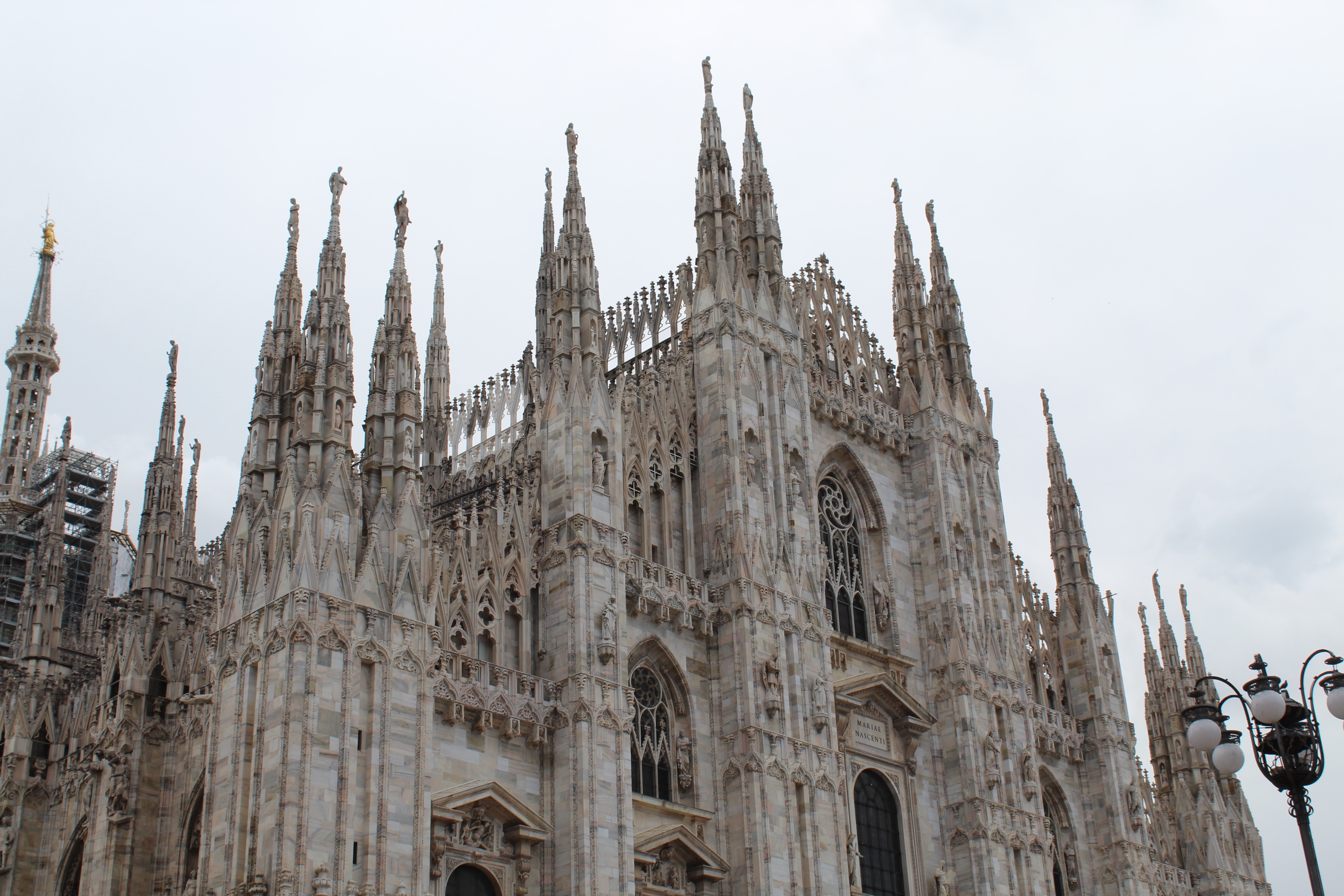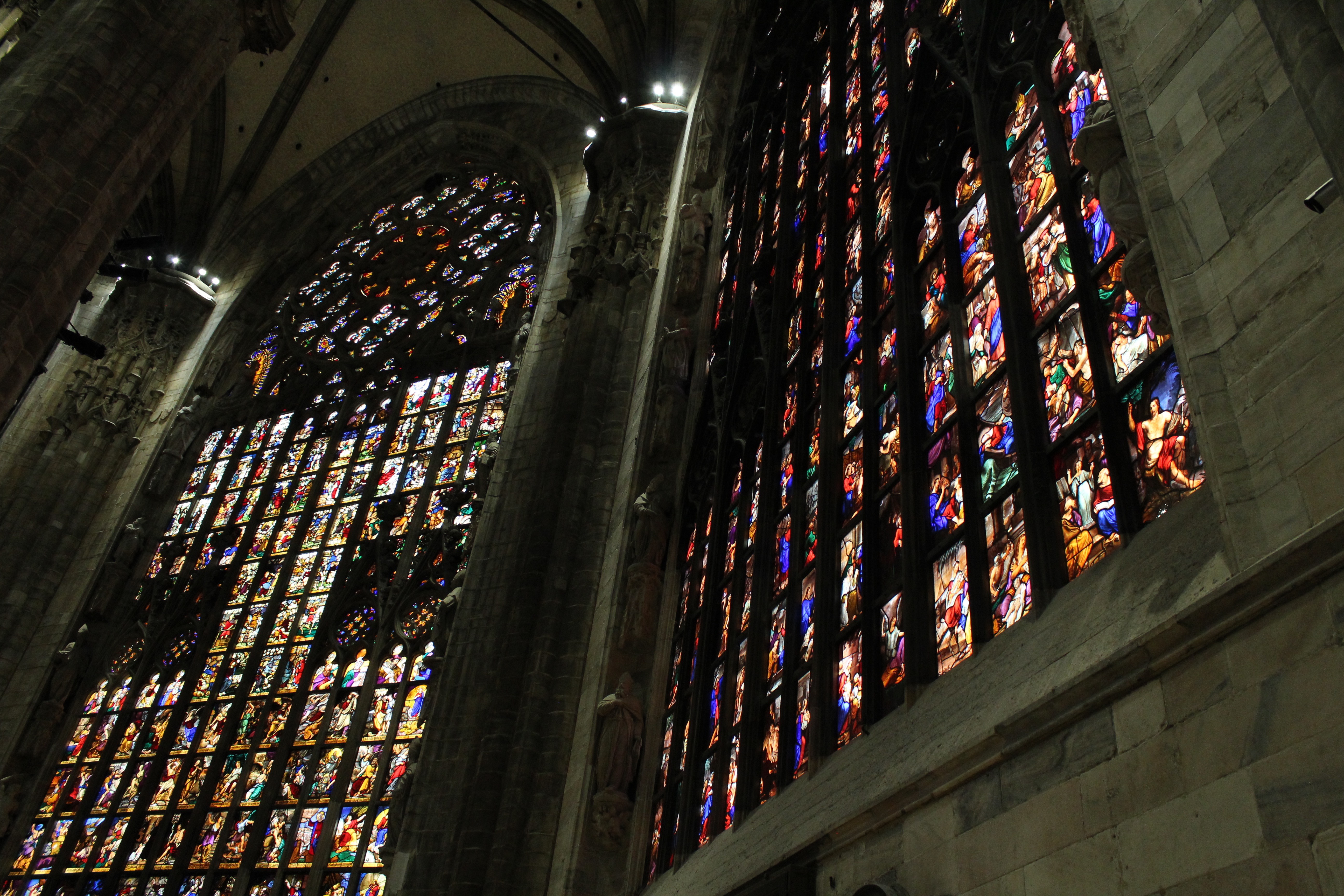Milan’s great structure at the center of it all – the Duomo
by: Carrie Reale

The Duomo stands tall in the city center of Milan, a two-minute walk away from dozens of high-end store fronts that bear the names Luis Vuitton, Chanel, Jimmy Choo and more. Milan itself is a beautiful blend of historic and modern, but the Duomo itself is at the center of Milan’s history.
The International Media and Education classes were guided through the Duomo by Simone on Tuesday, May 15. As the group made its way through the church and between the pews, Simone’s words served as a narrative.
Simone began the tour with talking about when the church was built. Taking nearly six centuries to build, the Duomo is the fourth largest cathedral in the world. It began construction in 1386 and was not finished until the 1800s. The building was dedicated to the Virgin Mary, and a gold statue of Mary adorns the building at the top, marking the highest point not only of the Duomo, but also the entire city of Milan itself; no building taller than Mary herself can be built within the city lines.
According the International Patrons of Duomo di Milano website, www.duomopatrons.org, the church has 100,000 weekly visitors, which adds up to over 6 million visitors per year. Simone told the group that visitors may wait hours to enter the church. As the group entered the church, Simone quietly said over the radio system we used on tours that the crowd that today is nothing compared to the busiest days that the Duomo sees.
The façade of the Duomo is a “hybrid” style, as Simone said, mixing gothic styles with baroque. However, the inside is entirely gothic, with the pillars stretching high from the floor to the ceiling. The highest pillar stands at 157 feet, but most stand at 140. Senior public relations and advertising major Kristina Pacifico liked the hybrid style of the church.
“It was interesting how the Duomo doesn’t have one cohesive theme,” Pacifico said. “It takes on various artistic styles and religious symbols to create one massive yet unbelievably beautiful cathedral.”

A visitor walks into the interior of the Duomo and is immediately outnumbered by the 40 stoic pillars and 16,000 organ pipes. The sides of the building hold 55 beautifully detailed stained glass windows, each of which tell a different story from the Bible.
Junior sports, arts and entertainment management major Megan Thorpe remembers being captivated by the stained glass artwork.

“My favorite part of the Duomo were definitely the stained glass windows,” Thorpe said. “The bright colors are compelling to me, and I love that each window depicts a different story. It amazes me that we can create beautiful designs like that.”
No paintings adorn the walls or ceilings of the Duomo – another mark of the gothic style. The artwork is in the form of the stained glass windows, mosaics, and the multiple sculptures that stand like guardians of the area. One sculpture in particular always stands out to visitors of the Duomo: St. Bartholomew.
St. Bartholomew is known as the apostle who was skinned alive and beheaded, and the image of a flayed Bartholomew is present in many important pieces of art, one of which being a painting my Michelangelo himself: “The Last Judgment” on the ceiling of the Sistine Chapel. Inside the Duomo, St. Bartholomew stands in the form of a tall statue that appears as though he does not have an outer layer of skin. This is an exact depiction of Bartholomew after he was skinned alive, and he in fact has his skin draped over his body. As Simone was recounting the information about St. Bartholomew, he had the group look at all sides of the figure. If one were to look to the rear of the statue, they would see St. Bartholomew’s former head draped across his shoulder and down his back.
Surrounding St. Bartholomew are more stained glass windows and an essential element of the Duomo. Just around the corner of where he stands is the entrance to St. Charles’ burial place directly under the front altar. St. Charles was the second patron of Milan and established rules and regulations for the Catholic Church that left a large impact on the church, giving him a reason to be preserved in his burial place under the altar of the Duomo.
In addition to being a historic landmark that millions of tourists visit every year, the Duomo in Milan is also a working church. According to www.duomomilano.it, the official website of the Duomo, people can attend a number of different services in the historic church. These services include Masses, celebrations, holiday services and an open prayer area. All services have an admission fee, except for the prayer area. The church also offers times for confessions to be heard.
As more and more tourists pass over the marble floors of the Duomo, the story of its construction and significance continue to be told. If someone stands in the Duomo of Milan, he or she cannot help but notice the truly amazing height of the ceilings and of the significance, as the purpose of the gothic style is to feel small.
As Thorpe recalls experiencing the Duomo, she remembers the beauty: “The Duomo in Milan was absolutely breathtaking. It’s the type of building you don’t believe is real until you see it in person.”
The Duomo is open daily 8 a.m. to 7 p.m., and admission fees vary. Complete passes to the Duomo are available as well. The last tickets are sold one hour before closing time. For more information, visit www.duomomilano.it.